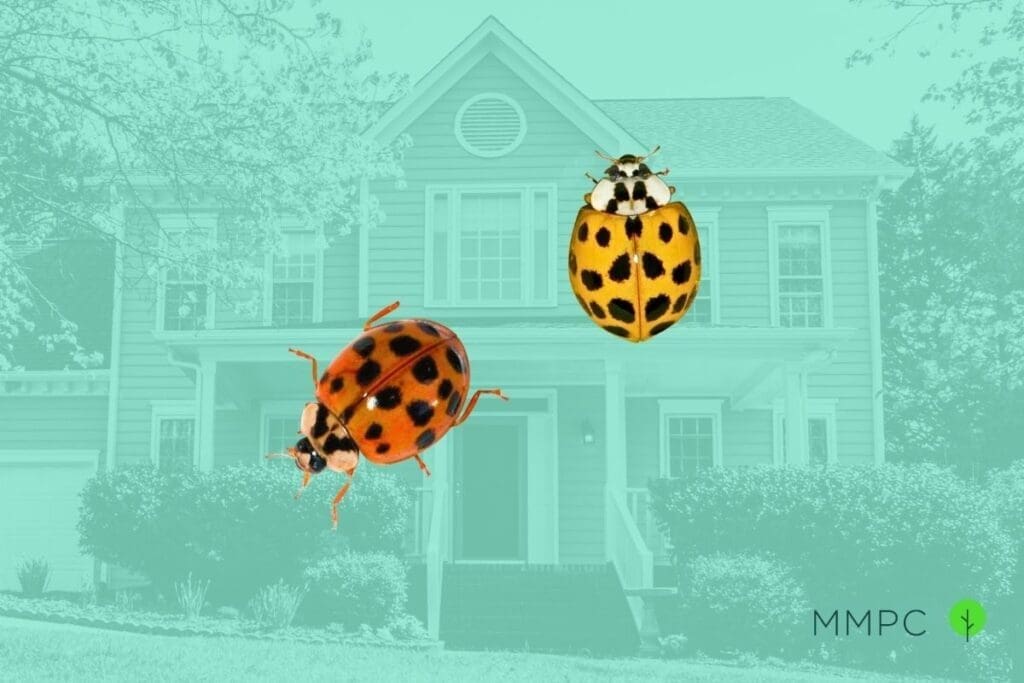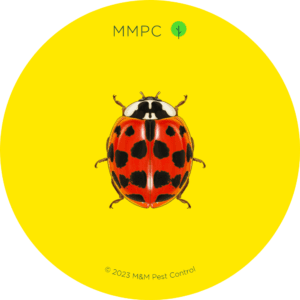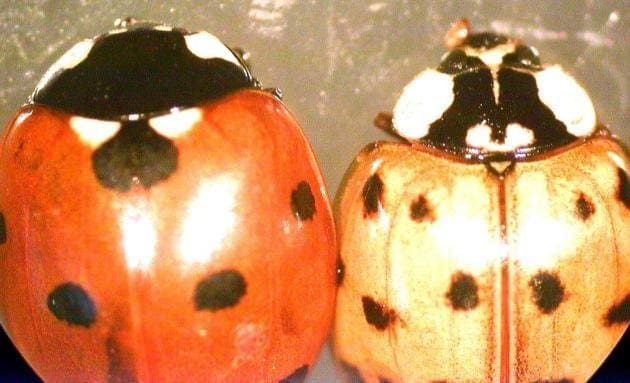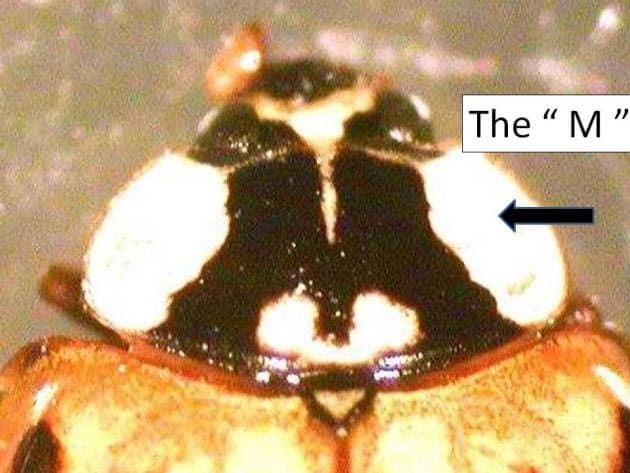
Asian lady beetles (Harmonia axyridis), also known as “multicolored Asian lady beetles,” are invasive insects commonly found in rural and suburban areas. Although they look similar to ladybugs, Asian lady beetles are considered pests while ladybugs are not.
In the fall, they gather in large swarms (called “aggregations“) and try to get into warm places, including peoples’ homes. Once inside, they release an foul-smelling pheromone that attracts more beetles into the house.
Their presence in the home is not only unpleasant due to the smell they release, but they can also cause airborne allergens, which may result in symptoms like asthma, swelling of the eyes, stuffy nose, sneezing, and coughing.
What are Asian Lady Beetles?

Originating in eastern Asia, these insects were originally introduced as a means to control aphids. They first arrived in the United States as stowaways on a freight ship. However, they were later recognized for their voracious appetite for pests and were deliberately imported and released by farmers as a natural pest control solution.
Today, Asian lady beetles are one of the most prevalent members of the Coccinellidae family in the United States, thriving in various regions.
Their primary food source is aphids, which are a common problem for gardeners as they can cause plants to yellow, wilt, and eventually die. Asian lady beetles are attracted to clusters of aphids and happily feast on them, providing gardeners with a natural solution to a frustrating problem.
This would be perfectly fine if the world wasn’t full of exceptions. Asian lady Beetles cannot eat our native aphids, which are too toxic for them. They also prey on lacewings and parasitoid wasps, which normally feed on these aphids. As the number of these predators dwindles, this leads to a boom in the native aphid population.
Asian lady beetles also consume more than a dozen species of ladybugs, including native ones that are already facing population decline. What’s even worse is that they can transmit a fungal parasite that they are immune to, but it is deadly for ladybugs.
How to Tell Asian Lady Beetles Apart from Lady Bugs
Asian lady beetles are coccinellid beetles with smooth, dome-shaped shells. They are usually about a quarter of an inch long and can vary in color from pale yellow to dark red-orange.
These pests are similar in appearance to native ladybugs, but there are some key differences:
- Ladybugs are usually bright red or orange with black spots, while Asian lady beetles can be red, orange, yellow, or even black with white, black, or red spots.
- While most ladybugs have between 2–7 spots on their backs, Asian lady beetles can have as many as 19 spots, or none at all.
- One of the most distinctive features of Asian lady beetles is a black mark on their heads in the shape of a M or W.

Are Asian Lady Beetles Harmful?
Apart from the ecological impact mentioned above, Asian lady beetles may also be a nuisance to people. Since they don’t do well in temperatures below freezing, they look for warm places to shelter in over the winter, and homes are a prime target.
However, Asian lady beetles are not pleasant guests because they tend to aggregate within the home, particularly in attics and basements, and emit a pheromone that attracts more beetles to the location. They emit a pungent odor that can last for months, even after the beetles have left. Squishing them worsens the smell and may also leave yellow stains on fabrics and painted surfaces.
In addition, if the beetles infest a room that’s frequented by people, they can create airborne allergens that may lead to symptoms such as asthma, swollen eyes, stuffy nose, sneezing, and coughing.
Although people in the city may not experience such issues, those in suburban and rural areas are likely familiar with the sight of curled-up beetle bodies scattered around window sills and unswept corners, as many of them tend to die over the winter.
How to Get Rid of Asian Lady Beetles in Your Home
Here are some steps you can take to get rid of Asian lady beetles:
1. Seal Openings
Seal any openings or cracks in the foundation or windows of the home to prevent them from entering in the first place. Check around basements and attics, as these are ideal locations for aggregations.
2. Vacuum
If they’re already inside, vacuum them up. Sweeping is another option, but this may cause them to release a defensive fluid that smells and stains.
Make sure to empty the vacuum into a garbage bag and close it tightly to prevent them from crawling back out. When you’re done, don’t just release them outside because they will reenter the house or find another place to crawl up into.
3. Diatomaceous Earth
Diatomaceous earth (an insecticidal dust that can be found in most home and garden stores) kills Asian lady beetles by damaging their exoskeleton, causing them to dehydrate and die.
Place food-grade diatomaceous earth in areas where Asian lady beetles aggregate, such as windowsills and doorways, and remove the bodies as soon as possible.
It’s important to note that while diatomaceous earth is generally considered safe for humans and pets, it can cause irritation to the lungs and skin if inhaled or ingested in large amounts. Use it with caution and always follow the instructions on the packaging.
4. Natural Repellants
You can passively repel Asian lady beetles by planting fall mums in your garden, as these flowers keep lady beetles far away (along with other common pests such as ticks and fleas). Alternatively, you can use herbs such as citronella and mint to achieve the same effect, as the strong smell is too overpowering for lady beetles.
5. Repaint Exterior Walls
When it comes to painting your house, selecting a darker color for exterior walls is an effective way to deter lady beetles from aggregating. This is because they naturally prefer light-colored cliffs to hibernate in, making tall light-colored homes incredibly appealing to them.
Get Professional Pest Control Help
If you’re having trouble getting rid of Asian lady beetles, or they just keep coming back every season, consider reaching out to your local pest control company for an inspection.
A licensed pest management professional, like the experts at MMPC, will be able to help identify any underlying issues that are causing your infestation and determine the best way to exterminate them from your home.

